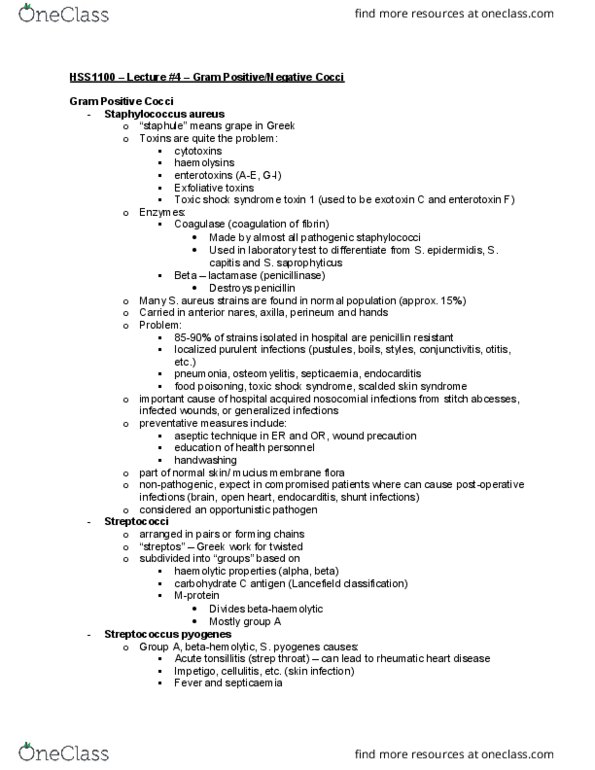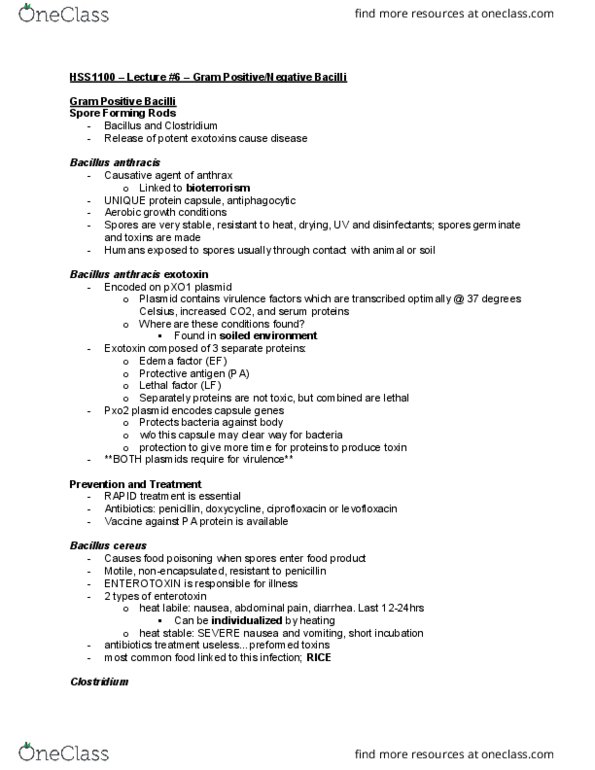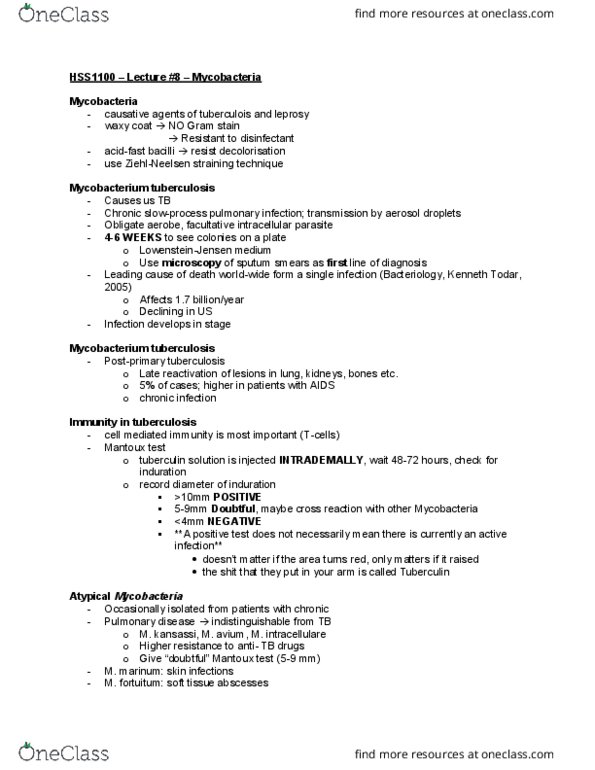HSS 1100 Lecture Notes - Lecture 6: Enterotoxin, Levofloxacin, Exotoxin
HSS 1100 verified notes
6/13View all

HSS1100 – Lecture #6 – Gram Positive/Negative Bacilli
Gram Positive Bacilli
Spore Forming Rods
- Bacillus and Clostridium
- Release of potent exotoxins cause disease
Bacillus anthracis
- Causative agent of anthrax
o Linked to bioterrorism
- UNIQUE protein capsule, antiphagocytic
- Aerobic growth conditions
- Spores are very stable, resistant to heat, drying, UV and disinfectants; spores germinate
and toxins are made
- Humans exposed to spores usually through contact with animal or soil
Bacillus anthracis exotoxin
- Encoded on pXO1 plasmid
o Plasmid contains virulence factors which are transcribed optimally @ 37 degrees
Celsius, increased CO2, and serum proteins
o Where are these conditions found?
▪ Found in soiled environment
- Exotoxin composed of 3 separate proteins:
o Edema factor (EF)
o Protective antigen (PA)
o Lethal factor (LF)
o Separately proteins are not toxic, but combined are lethal
- Pxo2 plasmid encodes capsule genes
o Protects bacteria against body
o w/o this capsule may clear way for bacteria
o protection to give more time for proteins to produce toxin
- **BOTH plasmids require for virulence**
Prevention and Treatment
- RAPID treatment is essential
- Antibiotics: penicillin, doxycycline, ciprofloxacin or levofloxacin
- Vaccine against PA protein is available
Bacillus cereus
- Causes food poisoning when spores enter food product
- Motile, non-encapsulated, resistant to penicillin
- ENTEROTOXIN is responsible for illness
- 2 types of enterotoxin
o heat labile: nausea, abdominal pain, diarrhea. Last 12-24hrs
▪ Can be individualized by heating
o heat stable: SEVERE nausea and vomiting, short incubation
- antibiotics treatment useless…preformed toxins
- most common food linked to this infection; RICE
Clostridium

- Anaerobic → differentiates this bacteria from other spore-forming bacilli
o If found in a oxygen present environment, they will change to spore form but
won’t be killed off
- Botulism, tetanus, gas gangrene and pseudomembranous colitis
- POWERFUL EXOTOXINS → RAPID DIAGNOSIS
Clostridium botulinum
- Rapidly fatal food poisoning from lethal neurotoxin
- Neurotoxic blocks Ach release in autonomic system; flaccid muscle paralysis:
o Afebrile, bilateral cranial nerve palsies, double vision, trouble swallowing, muscle
weakness
o Respiratory paralysis → DEATH
o Treatment: antitoxins and respiratory assistance
▪ Rapid diagnosis and treatment necessary
- Smoked fish, improperly canned vegetables
o Proper cooking destroys spores
Action of Botulinum Neurotoxin (Powerpoint, slide #9)
Infant Botulism
- Honey contamination with spores
o Spores germinate and bacteria colonizes intestine
o Neurotoxin release
o 2-3 days of constipation
o trouble swallowing, muscle weakness
Clostridium tetani
- tetanus
- rusty nail contaminated with spores punctures skin; wound provides anaerobic
environment
- exotoxin: tetanospasmin
o sustained contractions of skeletal muscles
o prevents muscles from relaxing
o severe muscle spasms (lock haw); high mortality at this stage
- Rapid diagnosis and treatment necessary
- booster (inactivated toxoid) given every 10 years
Clostridium perfringens
- gas gangrene
- severe necrosis of tissue
- seen in soldiers wounded in battle
o a localized anaerobic environment is created, allowing spores to multiply and
make toxics
- 2 classes of infections:
o wound infection/cellulitis
▪ necrotic skin exposed to bacteria, damage to local tissues; skin feels
moist, spongy, with ‘crackly’ pockets
o clostridial myonecrosis
▪ bacteria inoculated from trauma into muscles; exotoxin secretion destroys
adjacent muscles; as muscles degrade get black fluid excreted from skin
▪ FATAL unless treated with oxygen, antibiotics (penicillin) and removal of
damaged tissue
Clostridium difficile
- Symptoms: severe diarrhea, abdominal cramping, fever
- Anaerobic
- Naturally resistant to a large number of antibiotics
- Possible cause of diarrhea in patients on antibiotics
o Very common in hospitals in Quebec
o Causes antibiotic-associated pseudomembranous colitis
- Seen more commonly in hospitals than tetanus, antrax or botulism
- Overuse of broad-spectrum antibiotics destroys normal intestinal flora
- Infects colon and releases exotoxins
o Toxin A: diarrhea
o Toxin B: cytotoxic to colon cells
- Treatment:
o Discontinue antibiotic treatment
o Administer metronidazole or vancomycin
▪ What is different about these antibiotics: not broad spectrum antibiotics
Non-Spore Forming Rods
- 2 medically important bacilli
o listeria monocytogenes and Corynebacterium diptheriae
Listeria monocytogenes
- Causative agent of listeriosis; immunocompromised are at high risk
- Found in foods such as soft cheeses, unpasteurized milk, cold cuts, pate
- PSYCHROPHILE → survive in refrigerator
o One of the few bacteria that can cross all 3 protective barrier
o Highest risk
- Elderly, pregnant women and fetus suffer the most from this
Document Summary
Hss1100 lecture #6 gram positive/negative bacilli. Causative agent of anthrax: linked to bioterrorism. Spores are very stable, resistant to heat, drying, uv and disinfectants; spores germinate and toxins are made. Humans exposed to spores usually through contact with animal or soil. Encoded on pxo1 plasmid: plasmid contains virulence factors which are transcribed optimally @ 37 degrees. Celsius, increased co2, and serum proteins: where are these conditions found, found in soiled environment. Exotoxin composed of 3 separate proteins: edema factor (ef, protective antigen (pa, lethal factor (lf, separately proteins are not toxic, but combined are lethal. Pxo2 plasmid encodes capsule genes: protects bacteria against body, w/o this capsule may clear way for bacteria, protection to give more time for proteins to produce toxin. Causes food poisoning when spores enter food product. 2 types of enterotoxin: heat labile: nausea, abdominal pain, diarrhea. Last 12-24hrs: can be individualized by heating, heat stable: severe nausea and vomiting, short incubation.




